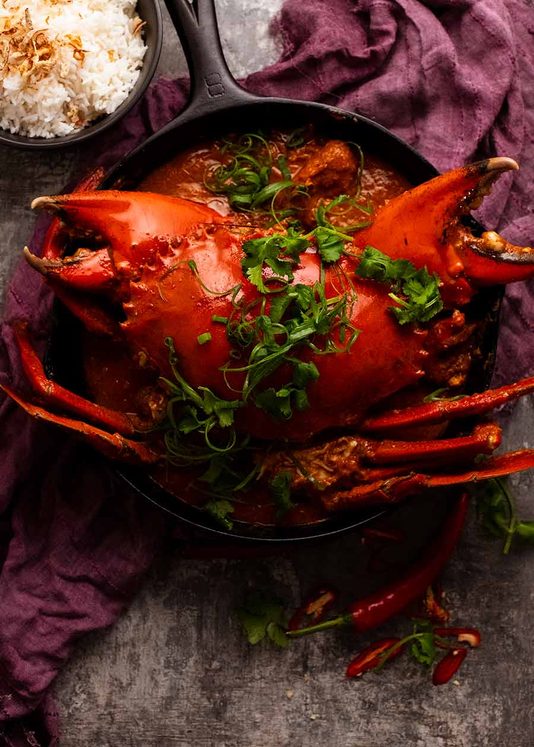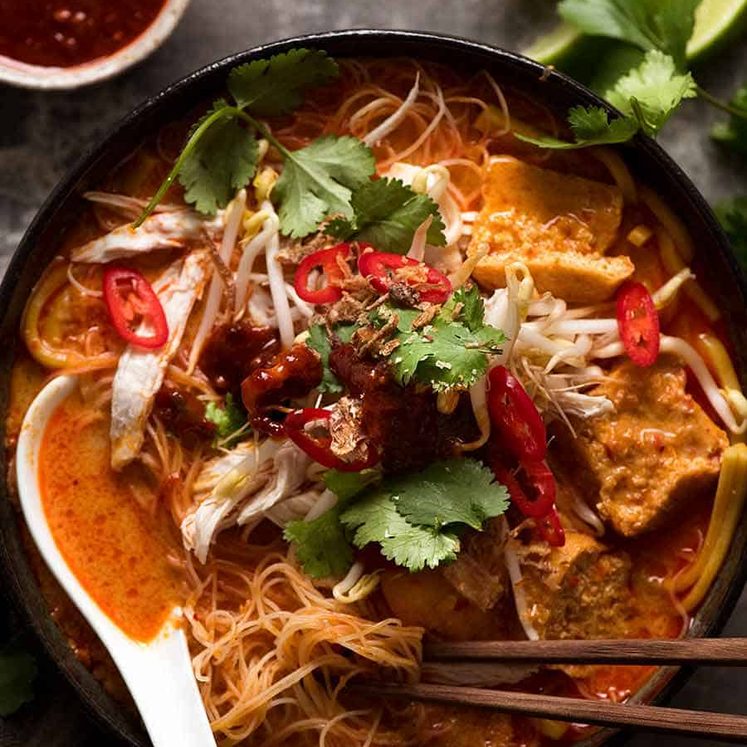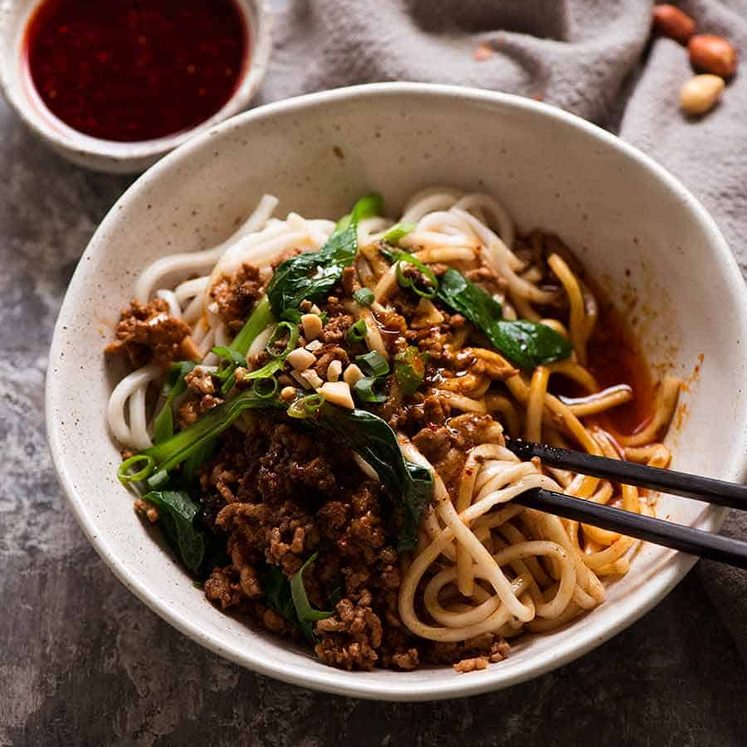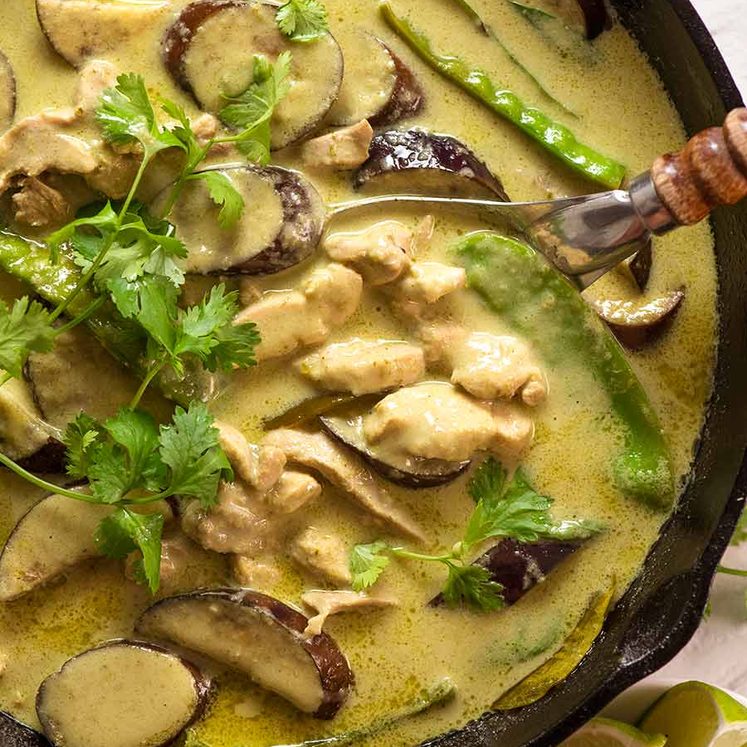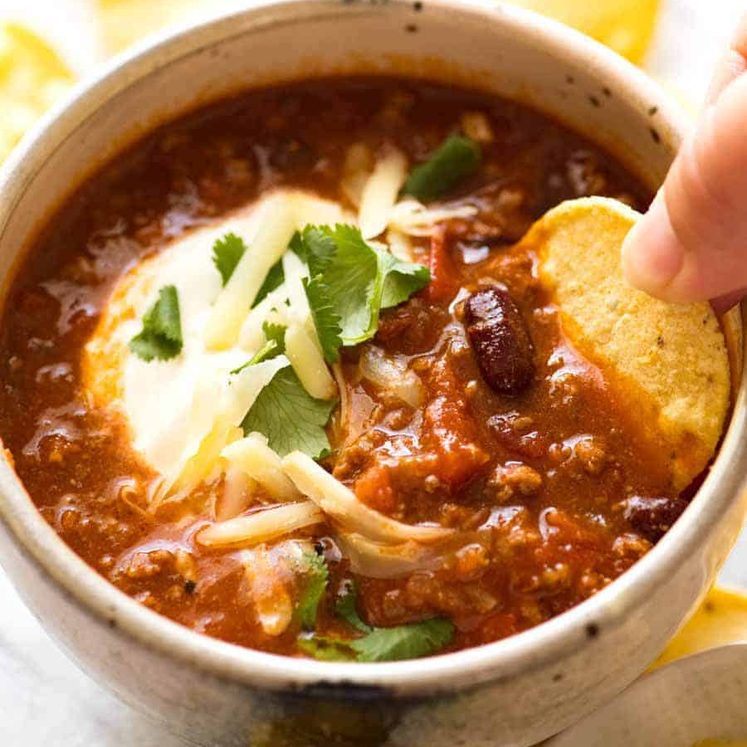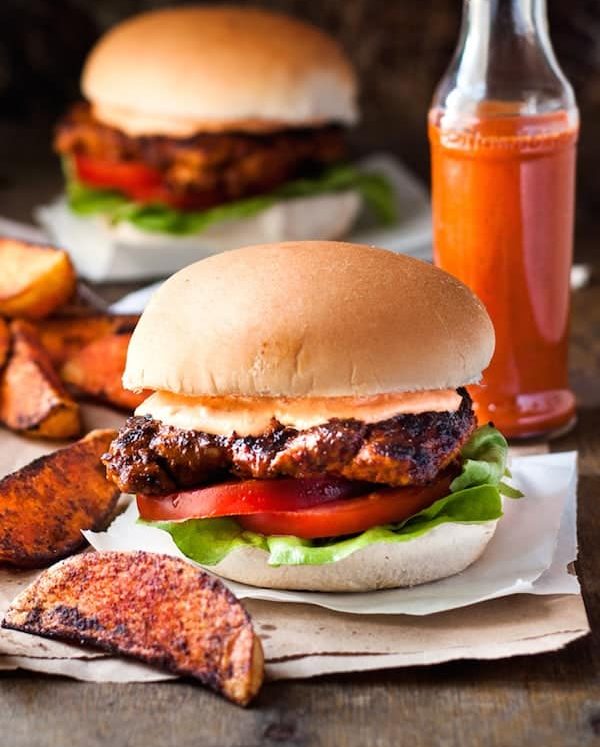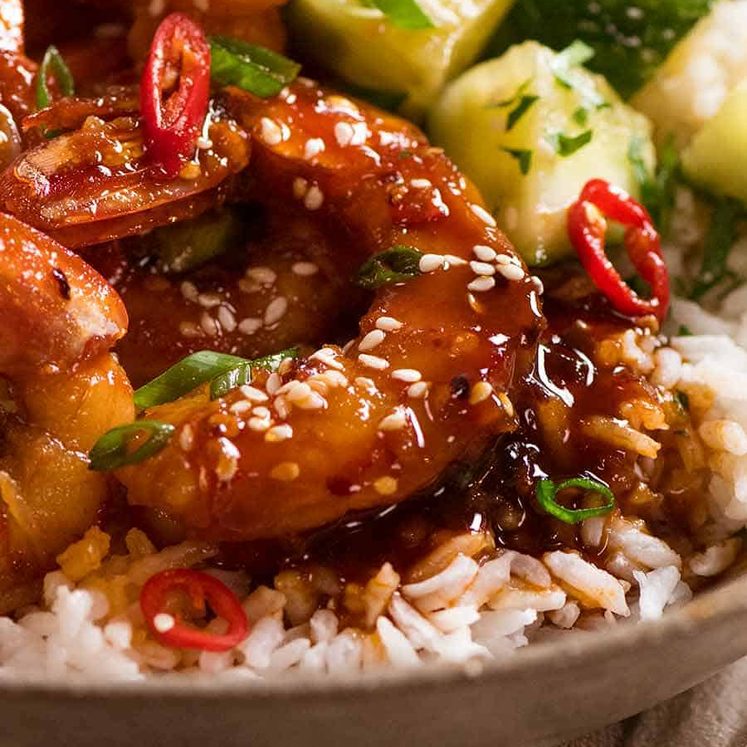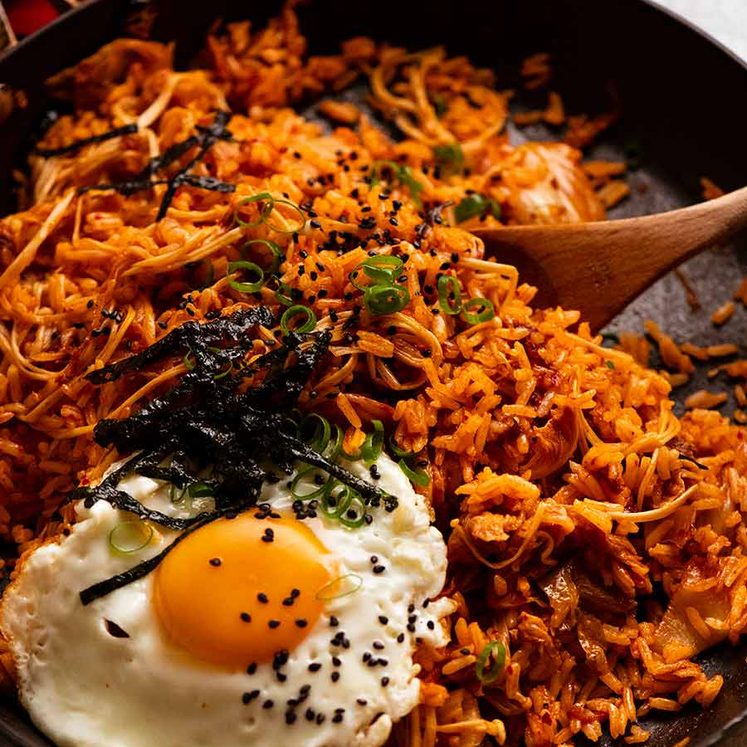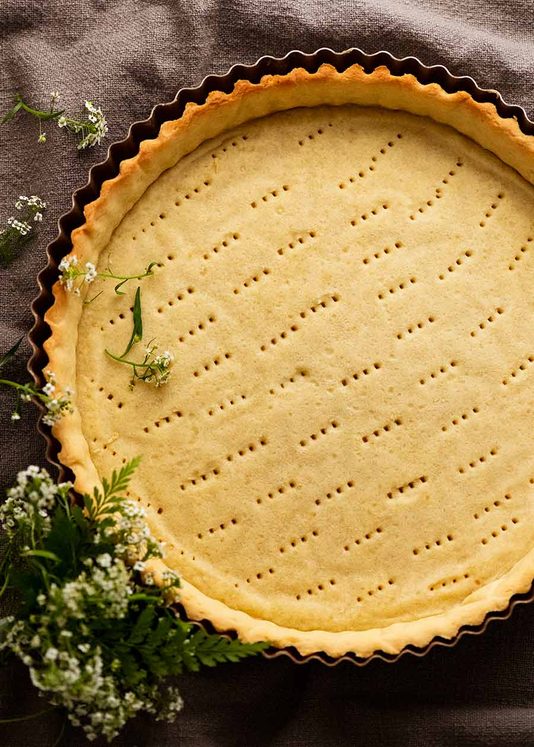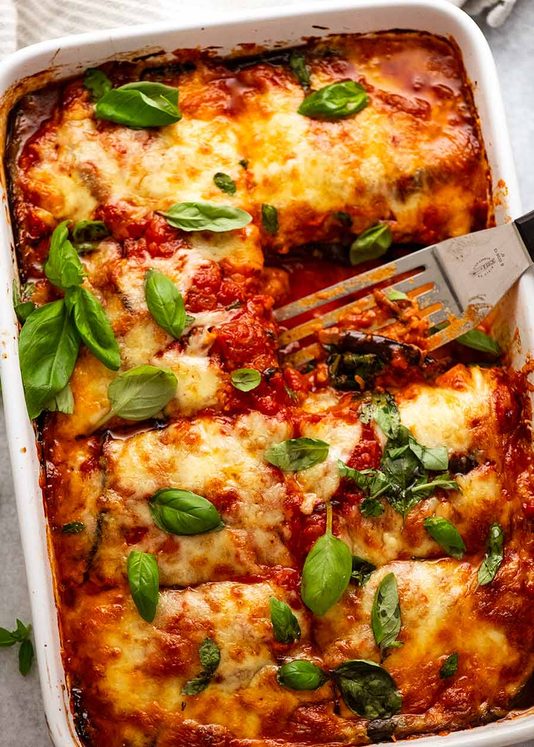Here’s arguably the most famous crab recipe in the world: Singapore Chilli Crab! For the ultimate experience, use live mud crab that you clean and cut yourself. Be prepared to get messy eating it (half the fun!) – and to be surprised at how quick it is to make!
The best part of this dish? The sauce. This stuff is the Mother Of All Flavour Bombs!
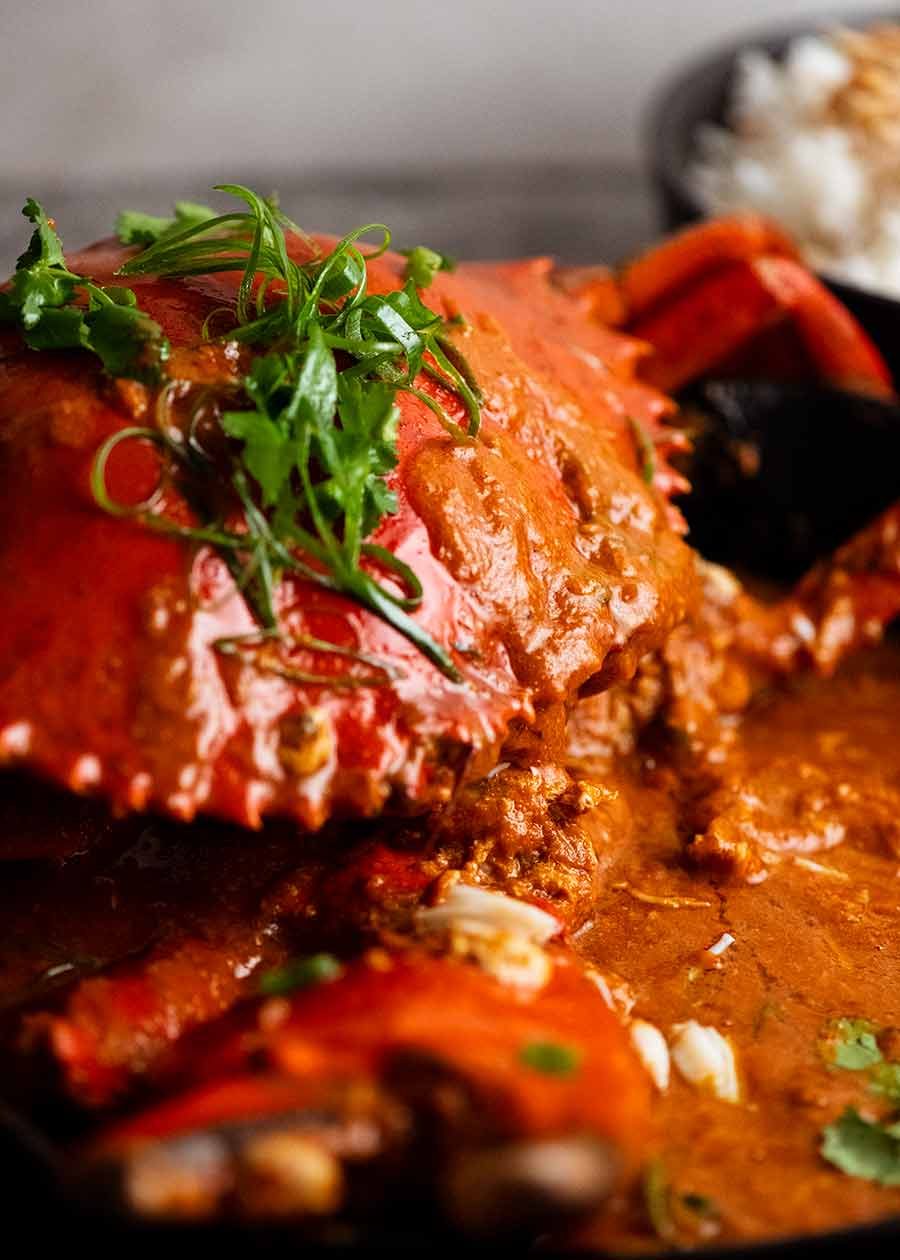
Any Singaporean will tell you the sauce is the beating heart of Singapore Chilli Crab. It’s an explosion of seafood flavour, less spicy than the name suggests, subtly sweet, deeply savoury. Sauce excellence at its finest!
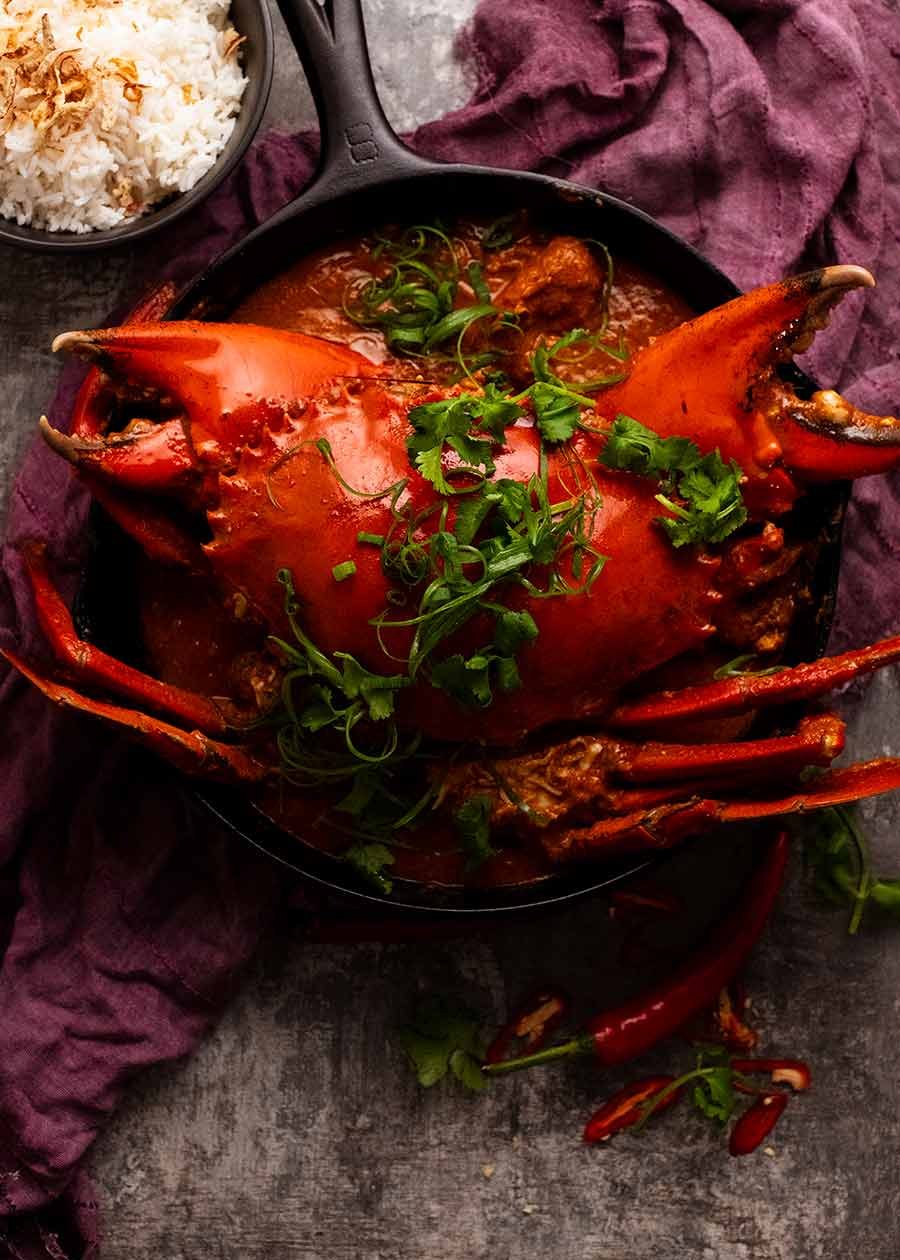
Singapore Chilli Crab
You’ve heard about it all your life, you might’ve even tried it on its home turf in Singapore. It is probably the most iconic crab dish in the world. It’s grand, it’s bold, it’s fun, and it’s an occasion. And of course, utterly delicious!
It’s a fact that crab, especially live, is expensive. So if you’re on the fence about why you should make this, here’s one reason: We think this recipe is miles better than any chilli crab we’ve tried even here in Sydney!
I know that is a pretty bold statement, nor am I one to blow my own trumpet. After all, Sydney is a food-lover’s playground, brimming with superb restaurants showcasing many of the world’s best cuisines. But the RecipeTin team AND my family have searched high and low, travelling far and wide to try Singapore Chilli Crab at well-known establishments around the city.
And yet, every single one has somehow fallen short of our expectations. Not the crab mind you – live crab cooked fresh is hard to get wrong, after all.
No, it’s the sauce. Any Singaporean will tell you the sauce is the beating heart of Singapore Chilli Crab. Yet the sauce at every Chilli Crab place we tried was either too sweet, lacked the requisite flavour kick, or just didn’t taste quite right.
So if there’s one thing I will stand behind in this Singapore Chilli Crab recipe, it’s this: The flavour in the sauce is extraordinary. Deeply complex, mildly spicy, with a perfect balance of sweet and savoury, this stuff is the Mother Of All Flavour Bombs. The Singapore Chilli Crab sauce is so good in fact, that words fail me. And that’s saying something!! 😂
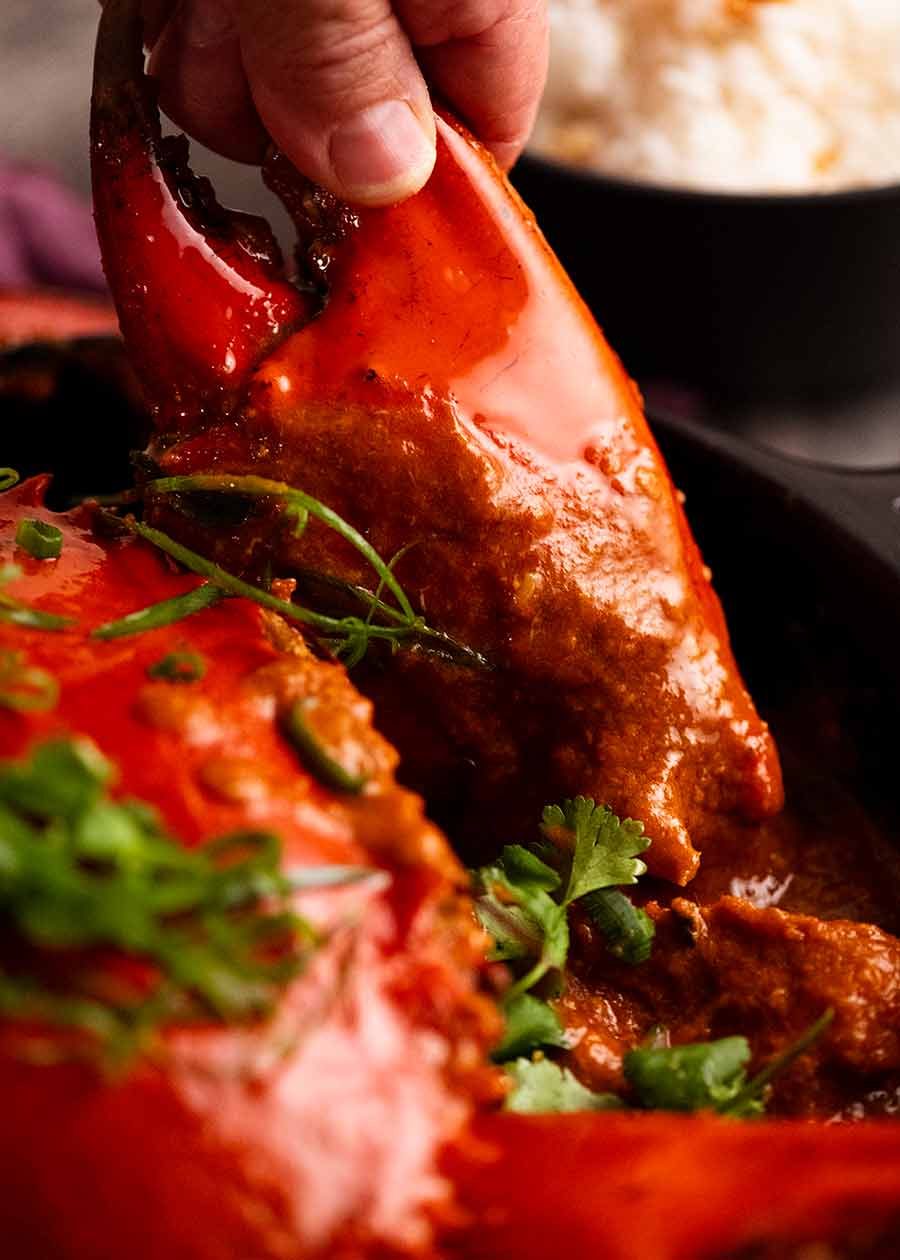

What you need for Singapore Chilli Crab
There’s 3 parts to Singapore Chilli Crab:
-
The crab – Fresh, live mud crab is the traditional crab used, prized for its sweet and meaty flesh. But any big crabs can be used;
-
The chilli paste – Somewhat like a Thai curry, the base of the sauce is made with fresh chillies and aromatics, all blitzed up to release the fresh flavour; and
-
The sauce – Many things go into it but three authentic, key ingredients that thrust the sauce to soaring flavour heights: the reserved crab tomalley from inside the crab (“crab mustard”), shrimp paste and ketchup. Read on for why!
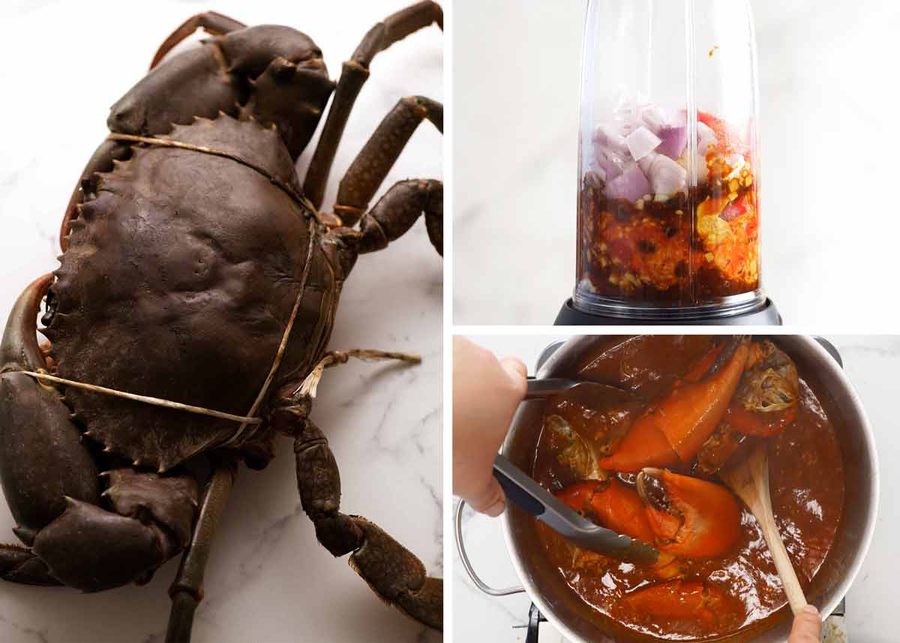
1. The crab
Live mud crab is the first and most traditional choice for the ultimate Singapore Chilli Crab eating experience. Known for their fearsomely large claws full of sweet, juicy meat, live mud crabs are sold in Australia and Asia at fish markets and large seafood shops.
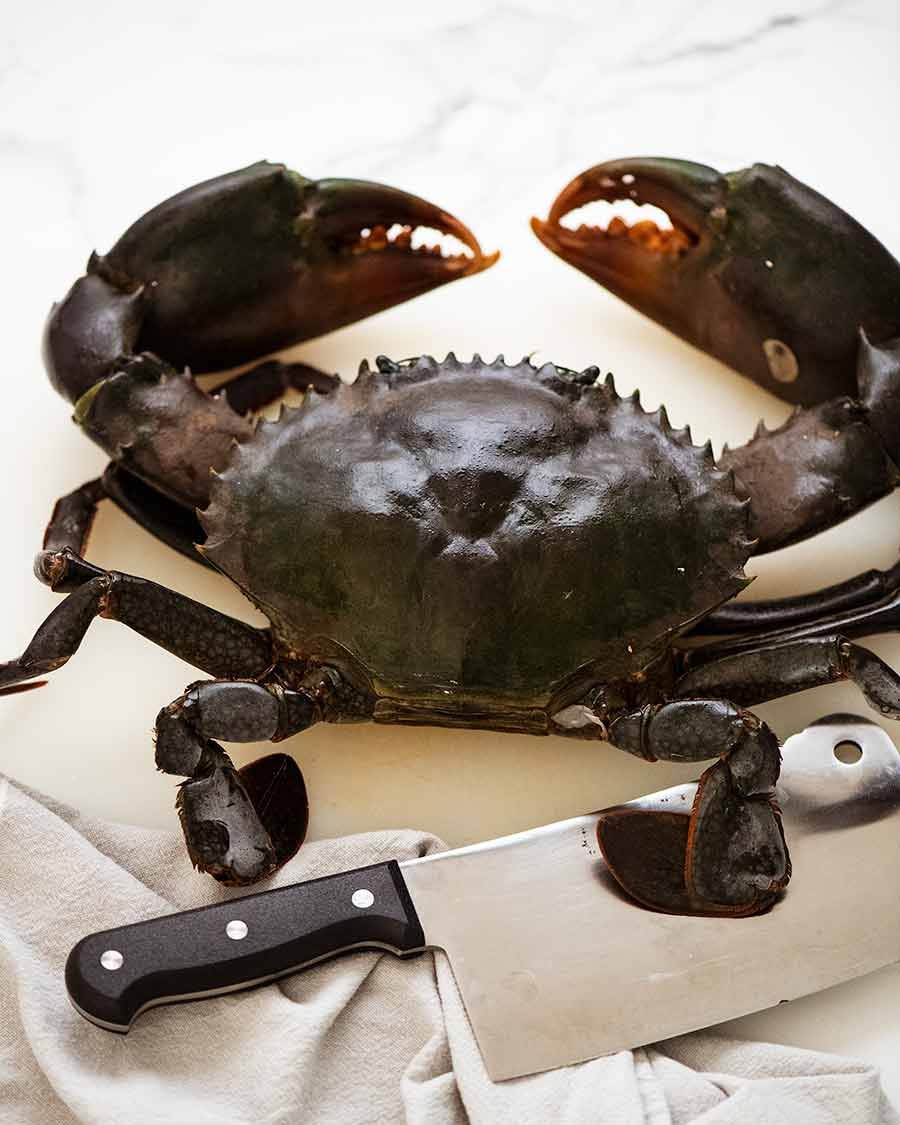
-

Mud crab sold at the Sydney Fish markets -

One of my favourite fish mongers at the Sydney Fish Markets
How to clean and cut crab
I’ve written a separate post on how to clean and prepare the crab.
The job is far easier than you think, especially when you have someone to hold your hand through the process (that would be me!) Dispatching the crab is not a stress either. You may have terrifying visions of engaging in hand-to-hand combat with a giant crustacean desperately fighting for its life, legs flailing and claws snapping. But I assure you it’s as simple as popping the bound critter into the freezer to until it sleeps.

After cutting the crab
Once the crab is cut up, you will end up with:
-
Crab pieces; and
-
Crab juice plus tomalleywhich is also affectionately known as “crab mustard”. It’s actually the liver and pancreas of the crab, and this stuff is crab gold! It is packed full of crab flavour and it’s a secret ingredient in Singapore Chilli Crab that gives the sauce a massive savoury boost.
-

Crab pieces -
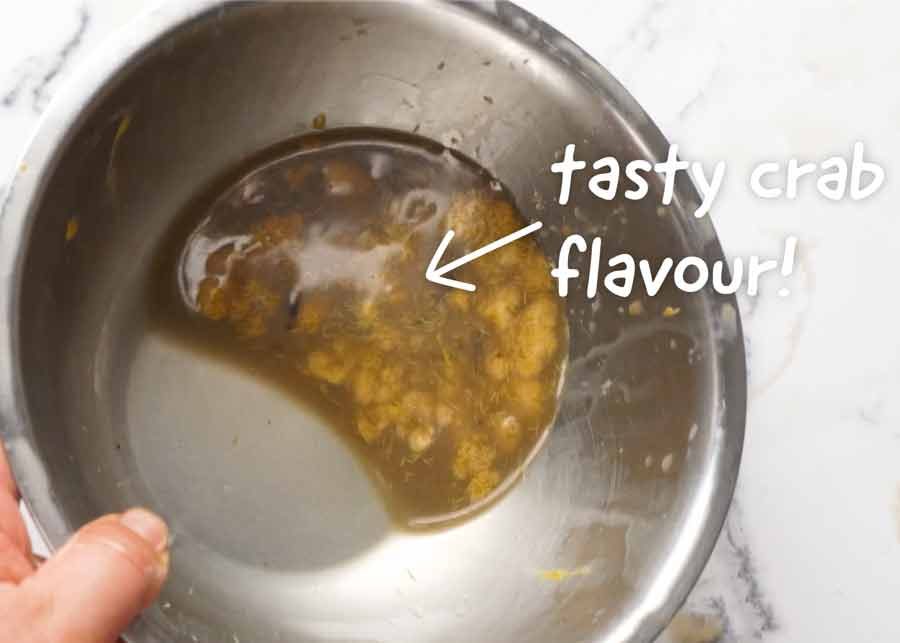
Reserved crab tomalley “crab mustard” for the sauce
Crab cutting service – special request
Also, I just found out just today that some seafood shops will cut the crab up for you on request, such as Claudio’s at the Sydney Fish Markets. Handy!
If the seafood store offers a service to cut the crab up for you, make sure you request the “tomalley” (“Crab mustard”) from inside the crab be reserved as this is one of the secret ingredients that’s make the sauce so incredible! See above for more information about tomalley.
Best crab for Singapore Chilli Crab
As noted above, the traditional crab used is a mud crab, around 1.5kg / 3 lb. Generally, bigger is better. Larger crabs are prized for their grandeur as well as ease of eating! But the dish can be made with any large crabs, such as:
-
Australia: Blue swimmer (smaller than mud crab, but the shell is softer so it’s easier to extract the meat), spanner crab (very little meat in the claws, but lots in the body)
-
America/Canada: Blue crab, dungeness crab, rock crab, stone crab
-
UK : Brown crab, spider crab
Here’s a photo of Singapore Chilli Crab made with blue swimmer crabs. Because they are smaller, I used 2 large crabs which totalled around 1.5kg/3lb. They taste is just as great as mud crabs, but they’re more fiddly to get the flesh out because they’re smaller!
-

Blue swimmer crabs – alternative crab option -

Singapore Chilli Crab made with Blue Swimmer Crabs
Fresh vs frozen crab
In order of preference:
-
Fresh, live crab is best –See separate post for how to clean and prepare live crab;
-
Fresh but not live – This is crab that is uncooked and not previously frozen. (Australia: These are crabs that are killed soon after catching to preserve flavour. Uncooked mud crabs can be found but blue swimmer crabs are more common.) Try to buy a whole crab you cut yourself rather than pre-cut, for optimum freshness;
-
Frozen raw crab – Whole or in pieces
I’m sorry to say pre-cooked crab (whether fresh or frozen) is not on the list. I’ve been disappointed far too many times in the past at the quality in Australia at least, lulled by big promises from fish mongers that don’t deliver. Also, the sauce really needs the crab juices that leach out as it cooks, it’s an essential part of the flavour!
Crabs not suitable for Singapore Chilli crab
-
Small crabs – You could but it’s a lot of work to extract not much meat!
-
King crab – This is a premium crab with sweet, incredibly meaty leg meat. While in Sydney you can buy uncooked king crab legs, I tend to think the strong flavours of this chilli sauce may overwhelm the delicate flavour. Feel free to try!
-
Snow crab – The flesh of this crab is quite delicate and crumbly, so I don’t think it would be suited to use in this dish.
If crab isn’t within your reach, make this recipe with prawns/shrimp instead. It’s phenomenal!
2. Singapore Chilli Crab chilli paste (sauce base)
Here’s what you need for the chilli paste which forms the base of the sauce:
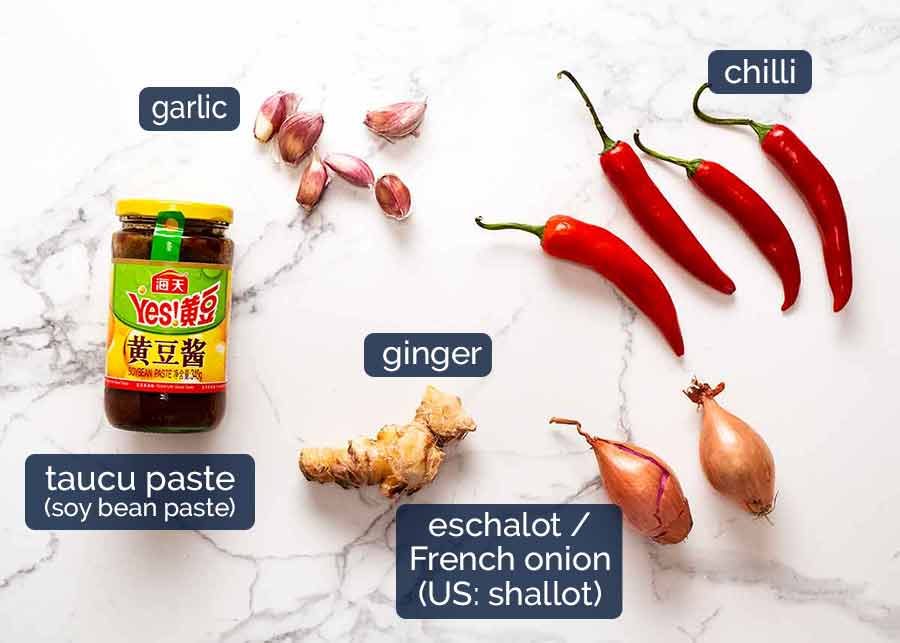
-
Taucu paste – This is a fermented yellow soy bean paste used in Indonesian, Malaysian and Singaporean cuisine. Believe it it or not, you can even get it at large grocery stores in Australia such as Woolworths (see here). It tastes a bit like miso paste and plays a similar role, adding deep savoury flavour to food. Substitute with Miso paste + a touch of sugar;
-
Fresh chillies – By using large red chillies, we get great chilli flavour in the sauce and colour without making it blow-your-head-off spicy. These are cayenne peppers. Singapore Chilli Crab is not meant to be insanely spicy! Feel free to reduce according to your taste. If you want to be conservative, shoot for a small amount as you can always beef up the chilli factor later by adding some chilli or hot sauce;
-
Eschalot – Also known as French onions, and are called “shallots” in the US. They look like baby onions, but have purple-skinned flesh, are finer and sweeter. Not to be confused with what some people in Australia call “shallots” ie the long green onions. Substitute with red onion; and
-
Ginger and garlic – Essential aromatics in Asian cooking!
3. Other Singapore Chilli Crab sauce ingredients
In addition to the chilli paste, here are the other ingredients required for the sauce:
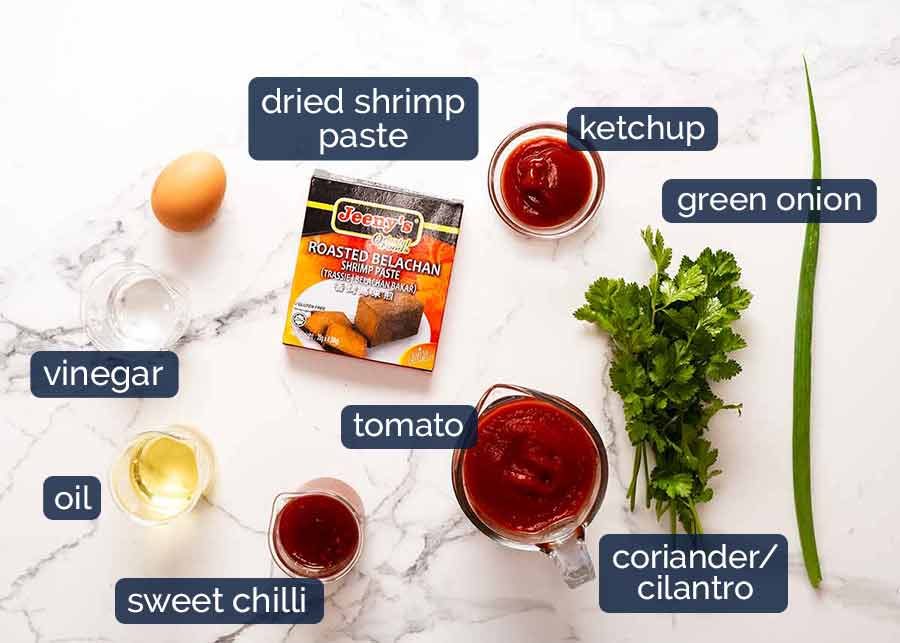
-
Roasted belachan shrimp paste – There’s no hiding it: this stuff stinks. It’s stinky out of the packet, and phenomenally stinky when you start cooking it. You may want to warn your neighbours. But once cooked, the offensive smell all but disappears and it adds an incredibly deep, savoury flavour into anything you use it in. Available even at grocery stores here in Australia (such as Woolies, Coles) and at Asian stores, it’s a key secret ingredient in this dish. There really is no substitute that will achieve the same result, but the best alternative is shrimp paste;
-
Ketchup – Yes, ketchup (tomato sauce to us Australians) is used in authentic Singapore Chilli Crab! Singapore is a melting pot of East meets West, and these influences are frequently embraced in the food. It’s another secret ingredient, used to add sweetness as well as rich tomato and spice notes. Don’t skip it!
-
Sweet chilli sauce – Just your stock-standard Asian (eg. Thai) sweet chilli sauce from any grocery store. It adds further sweetness and some gingery warmth to the sauce;
-
Tomato passata or puree – Not to be confused with tomato paste which is a thick, concentrated and sour paste, tomato passata is pureed, strained pure tomatoes. Sometimes labelled Tomato Puree in the US (here’s a photo of Mutti Tomato Passata sold at Walmart). Readily available in Australian supermarkets nowadays, alongside pasta sauces;
-
Egg –Whisked egg is mixed into the simmering sauce at the end to create an attractive marbling effect from the cooked egg, a signature of Singapore Chilli Crab;
-
Vinegar – A sour dimension is the third flavour pillar together with sweetness and savouriness. It’s essential for balance in Singapore Chill Crab sauce;
-
Green onion and coriander / cilantro – For garnish.
How to make Singapore Chilli Crab
The actual cooking part is phenomenally straightforward. In fact, people in my team who have made this recipe all comment on how it takes more effort to eat this dish than to make it!!!
Part 1: Making the sauce
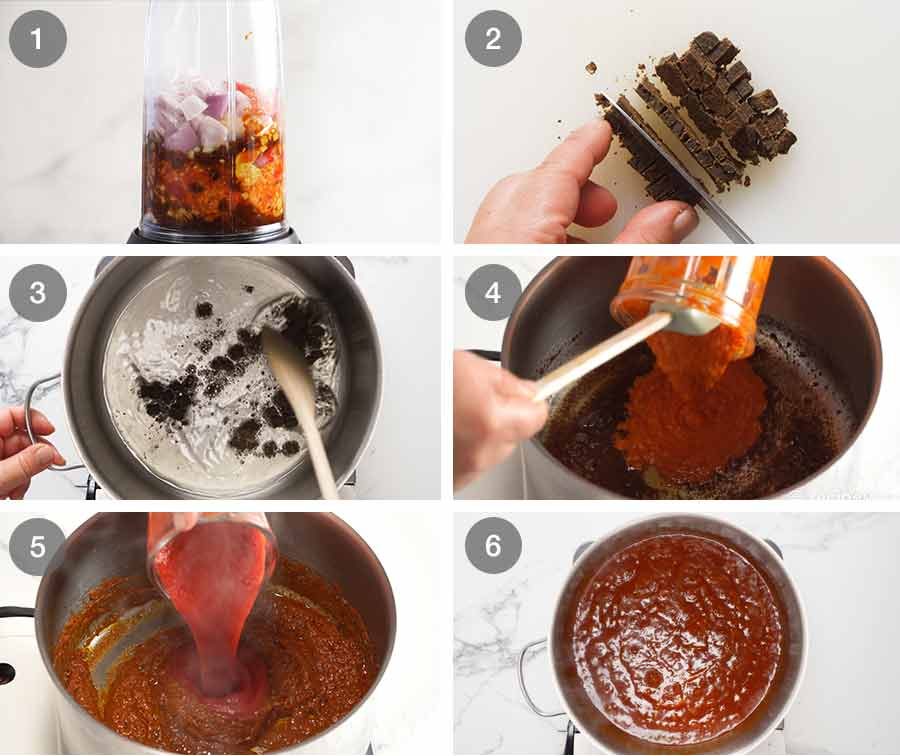
-
Chilli paste: Place ingredients in a small food processor or Nutribullet. Blitz until it’s a paste;
-
Belachan: Remove from the packet (it comes in little blocks) and roughly chop. You think it’s stinky now, wait until you start cooking it!
-
Sauté belachan: Heat oil in a large pot over medium-high heat. Add belachan and cook for 2 minutes, stirring constantly. The smell will make your hair stand on end, but have faith! It will transform into something beautiful. Think caterpillars and butterflies …
-
Cook off chilli paste: Add chilli paste and cook, stirring, for 3 minutes.
-
Add tomato passata: Add tomato passata and cook, stirring regularly, for 4 minutes.
-
Add remaining sauce ingredients: Add sweet chilli sauce, ketchup, water and stir to combine. Bring to simmer. Now we’re ready to cook the crab!
Part 2:
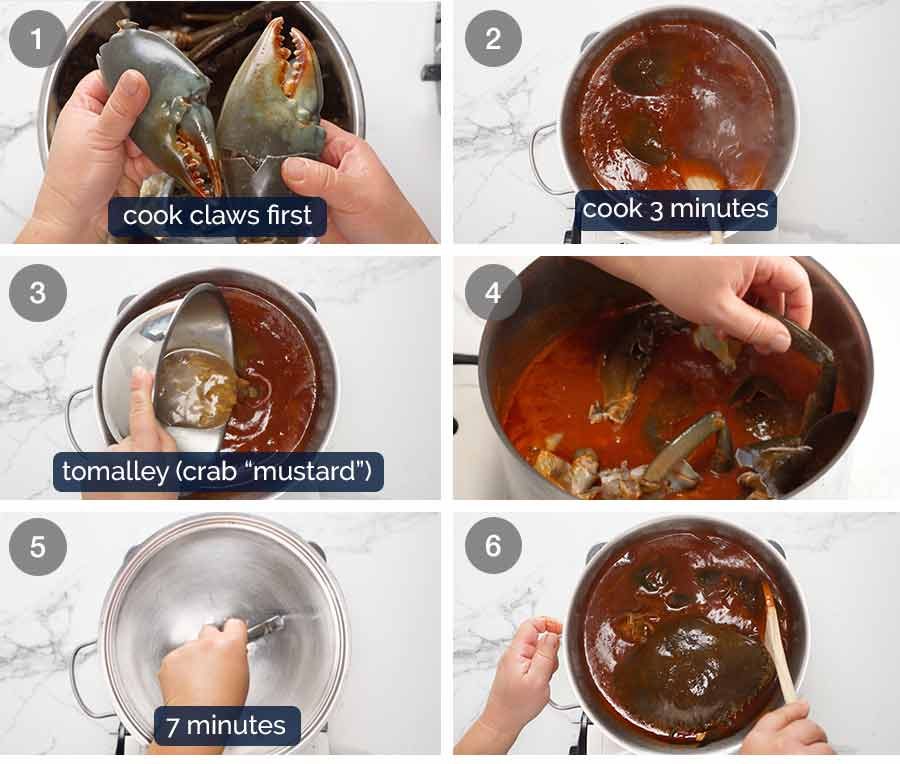
-
Add claws: We’re going to cook the claws first because they take the longest. If you are not using mud crab and the claws aren’t as big, you might not need to do this;
-
Cook claws 3 minutes: Put the claws in the pot, and stir to coat in sauce. Bring to a boil, then reduce heat to simmer. Cover with lid and cook 3 minutes;
-
Add “crab mustard”: Remove lid, then add the reserved tomalley (“crab mustard”) along with all the crab juices;
-
Add remaining crab: Add all the remaining crab parts, as well as any juices that are in the bowl.;
-
Cook 7 minutes: Stir well to coat, put the lid back on and cook for 7 minutes;
-
Crab done, move on to finishing sauce: The crab is now cooked. Now we just need to finish the sauce!
Part 3: Finishing the sauce

-
Remove crab: Use tongs to remove all the crab pieces. We do this because we need to mix egg and vinegar into the sauce and it’s easier to do without the crab in the pot;
-
Transfer to bowl: Transfer all the crab pieces to a bowl;
-
Egg ribbons: With the sauce still on the stove, while stirring in a circular stirring motion, pour the egg in a thin stream into the middle of the pot. This will create little ribbons of cooked eggs the sauce;
-
Vinegar: Finally stir in vinegar;
-
Return crab: Return the crab pieces to the pot;
-
Coat in sauce: Gently stir to coat all the crab pieces in the sauce.
And you’re done! Now it’s just time to plate up!
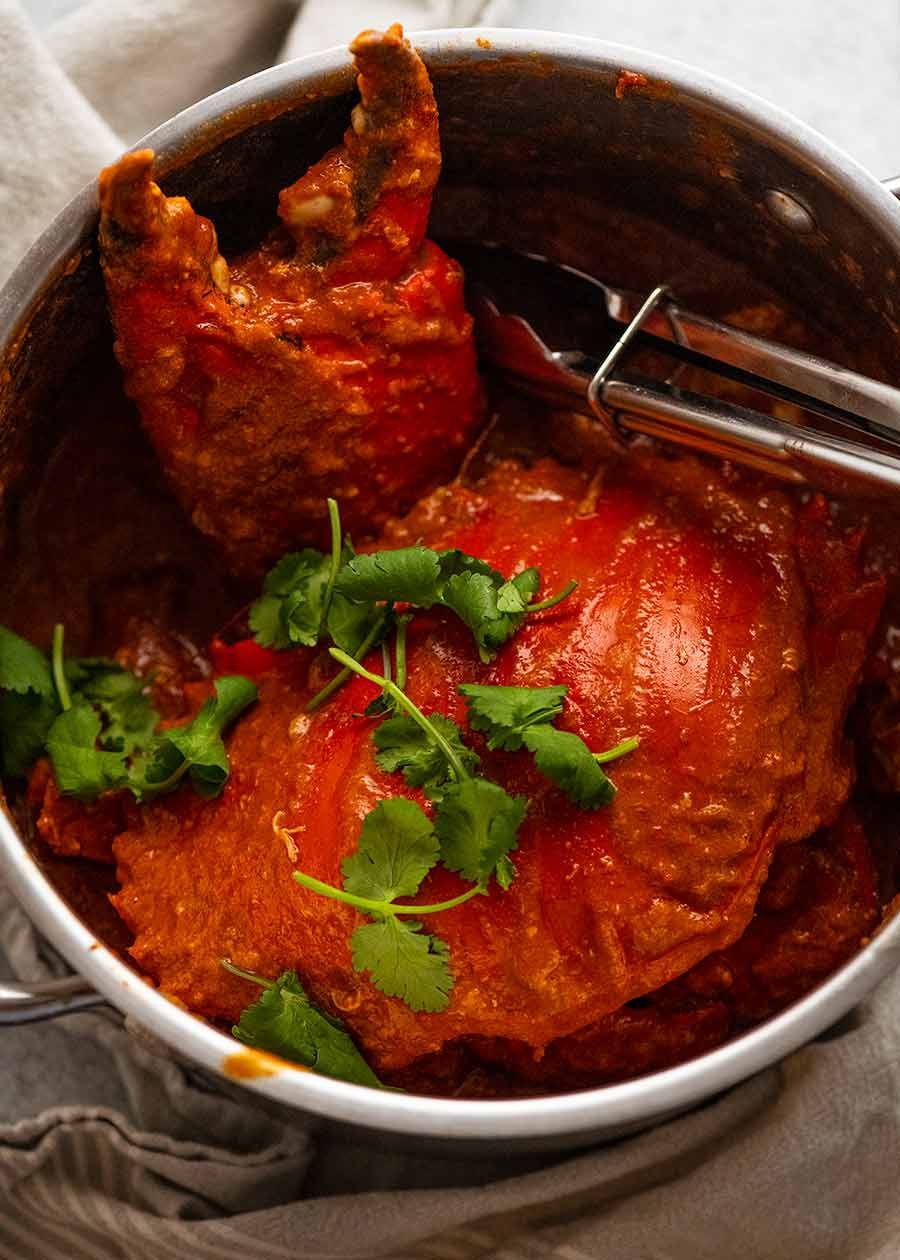
Part 4: Plating up
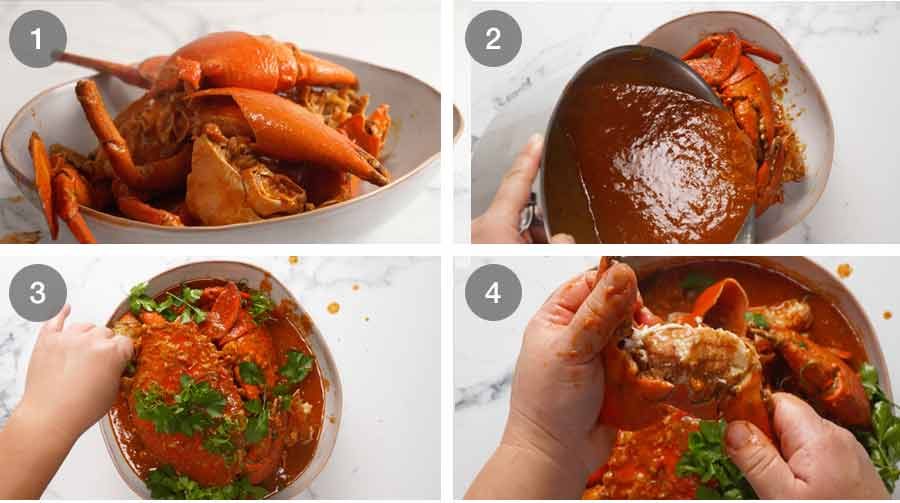
-
Transfer and arrange crab pieces in a large, shallow serving dish;
-
Pour over the sauce. All of it!
-
Garnish with fresh coriander/cilantro and green onion;
-
Dive in and devour while it’s hot and fresh!
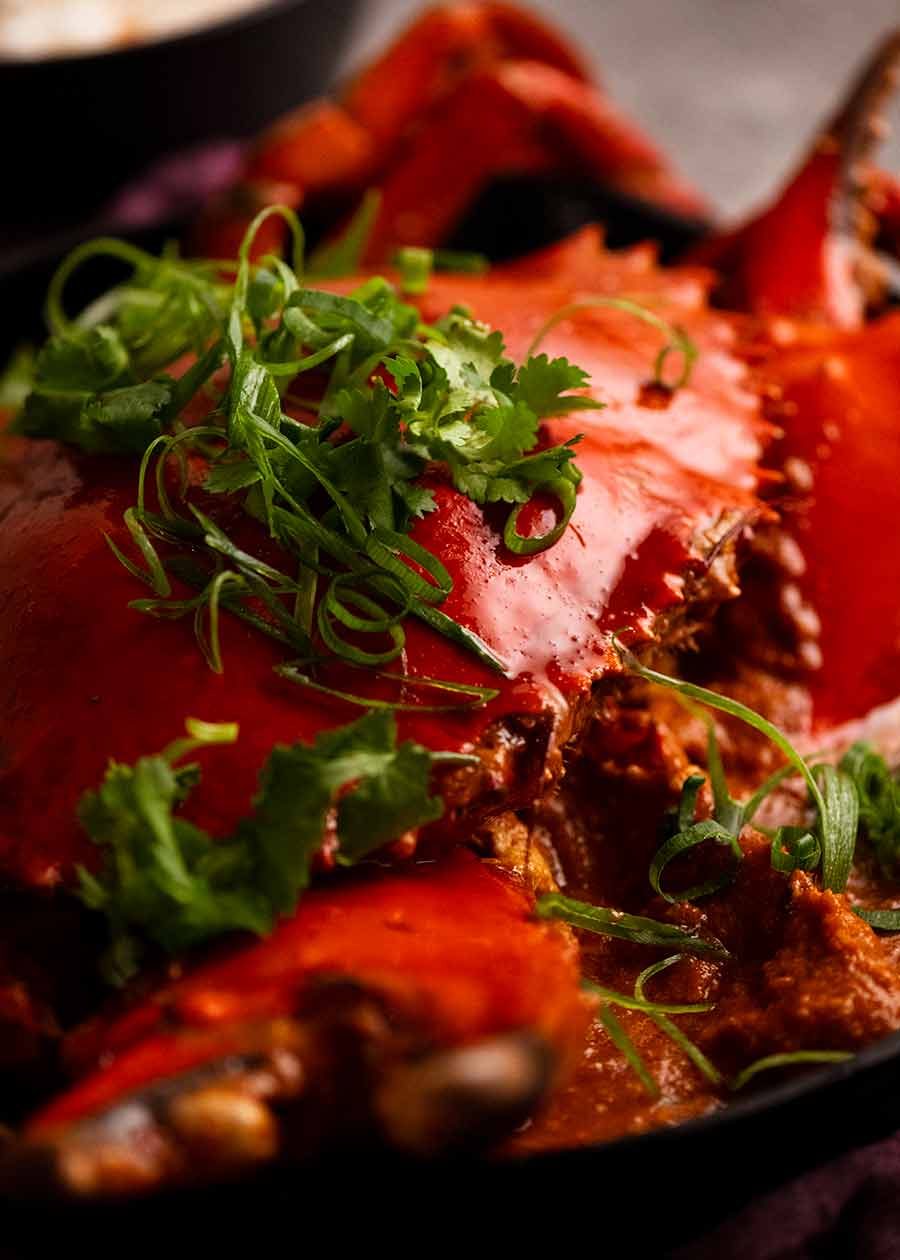
How to serve Singapore Chilli Crab
Singapore Chilli Crab is a dish made for sharing. Gather your nearest and dearest (nobody else is deserving! 😉), roll up your sleeves and get stuck in with your hands. There’s no two ways about it, you’re going to get messy – very messy! (Wait until you see the eat scene at the end of the recipe video!! 😂)
Traditionally in Singapore, Chilli Crab is served with a stack of golden mantou buns. These steamed and fried, fluffy Chinese buns make the perfect vessel for mopping up all that lip-smacking sauce. These can be hard to source though, so a baguette, crusty loaf or even soft dinner rolls are perfectly good alternatives.
Though if you want the best, make homemade brioche. Think – soft buttery bread dunked in hot spicy flavour loaded sauce…. *her needs buckle at the mere thought!*
Rice naturally also pairs perfectly well, but you’ll find your chopsticks get slippery pretty quickly!

This recipe is a big deal!
Ending on a serious note though, this is probably one of the most iconic “big deal” recipes I’ve shared on my website since I started it 6 years ago. Initiated because I just couldn’t find great Singapore Crab anywhere in Sydney, and this sort of food is me on a plate. Bold flavours, messy food you eat with your hands.
When I set out to do this, I had never handled a whole crab before. And certainly never tackled a live mud crab before.
It’s been a labour of love, learning how to clean and prepare crab, developing what I think is the ultimate Singapore Chilli Crab recipe, but most of all, the time consuming process of documenting it. Videos, photos, writing.
That I can show people from all around the world how to make my favourite dishes, this is what gets me out of bed every day, that motivates me to do the very best I can in every facet of what I do.
Sounds corny? Perhaps. Though actually, I’m just trying to explain, perhaps to myself, why I’ve put so much effort into one single recipe!
I truly hope you give this dish a go one day. It’s epic! – Nagi x
Watch how to make it
Hungry for more? Subscribe to my newsletter and follow along on Facebook, Pinterest and Instagram for all of the latest updates.
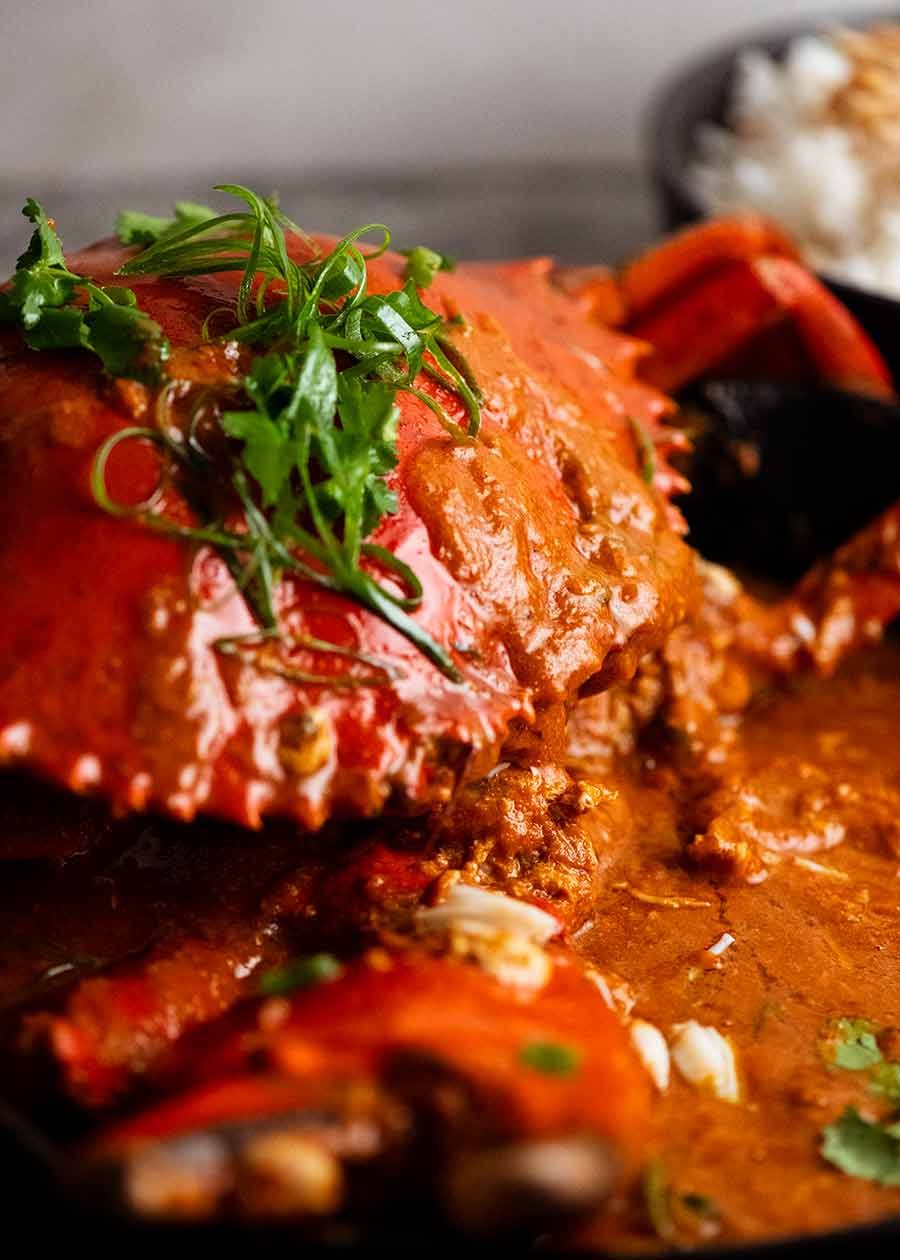
Singapore Chilli Crab
#wprm-recipe-rating-0 .wprm-rating-star.wprm-rating-star-full svg * { fill: #343434; }#wprm-recipe-rating-0 .wprm-rating-star.wprm-rating-star-33 svg * { fill: url(#wprm-recipe-rating-0-33); }#wprm-recipe-rating-0 .wprm-rating-star.wprm-rating-star-50 svg * { fill: url(#wprm-recipe-rating-0-50); }#wprm-recipe-rating-0 .wprm-rating-star.wprm-rating-star-66 svg * { fill: url(#wprm-recipe-rating-0-66); }linearGradient#wprm-recipe-rating-0-33 stop { stop-color: #343434; }linearGradient#wprm-recipe-rating-0-50 stop { stop-color: #343434; }linearGradient#wprm-recipe-rating-0-66 stop { stop-color: #343434; }
Ingredients
- 1.5 kg / 3lblive mud crab or other large, fresh crab, cut into large portion size pieces and tomalley reserved (“crab mustard”) (Note 1)
Chilli paste:
- 5red cayenne chilli, seeds left in, roughly chopped (Note 2)
- 2tbsptaucu paste(fermeted soy paste, sub miso Note 3)
- 6garlic cloves(small), roughly chopped
- 2eschalots(small), roughly chopped (Note 4)
- 3tbspginger, roughly chopped (~7.5cm / 3″ piece)
Singapore Chilli Crab Sauce:
- 1/4cupcanola oil
- 1tbspbelachan dried shrimp paste, chopped (sub shrimp paste, Note 5)
- 1cuptomato passata(Note 6)
- 1/2cupsweet chilli sauce
- 2tbspketchup
- 2cupswater
- 1egg, lightly whisked
- 3tbspwhite vinegar
Garnishes/serving:
- Fresh coriander, leaves whole or roughly chopped
- 2tbspgreen onion, finely sliced (or 1/4 cup finely sliced on angle, ice water 3 minutes for slight curl)
- Golden mantou buns(Note 7)
Instructions
-
Prepare crab: See separate tutorial for how to clean and cut a whole crab. You will end up with: 1) Crab pieces; and 2) Reserved tomalley (“crab mustard”, Note 8) and crab juices in a separate bowl. This is a key “secret ingredient” used to flavour the sauce.
-
Chilli paste: Place ingredients in a small food processor or Nutribullet. Blitz until it’s a fairly smooth paste.
-
Sauté belachan: Heat oil in a large pot over medium-high heat. Add belachan and cook for 2 minutes, stirring constantly. It will smell pungent (to put it mildly), but have faith! It will mellow and transform!
-
Cook off chilli paste: Add chilli paste and cook, stirring, for 3 minutes.
-
Add tomato passata: Add tomato passata and cook, stirring regularly, for 4 minutes.
-
Add remaining sauce ingredients: Add sweet chilli sauce, ketchup, water and stir to combine.
-
Add claws: Add the crab claws first (they take longer to cook), stir to coat in sauce. Bring to a boil, then reduce heat to simmer. Cover with a lid and cook 3 minutes.
-
Add “crab mustard” and juices: Add the reserved tomalley (“crab mustard”) along with all the crab juices.
-
Add remaining crab pieces: Remove lid, add remaining crab pieces and any juices that have collected in this bowl. Stir pieces to coat, put the lid back on and cook for 7 minutes.
-
Remove crab: Use tongs to remove crab pieces into a bowl.
-
Egg ribbons: With the sauce still on the stove, and while stirring in a circular motion, pour the egg in a thin stream into the middle of the pot. This will create little ribbons of egg in the sauce that is traditional and look lovely.
-
Vinegar: Stir in vinegar.
-
Return crab: Return the crab pieces into the pot, gently stir to coat in the sauce.
Plating up and serving:
-
Transfer crab pieces into a large serving plate or shallow dish. Pour over all the sauce from the pot. Garnish with coriander and green onion.
-
Serve with golden mantou buns (steamed and fried Chinese buns, traditional – Note 7), or homemade brioche (ultimate sub!), baguette, crusty bread or dinner rolls. Alternatively serve with rice on the side.
-
How to eat: Be prepared to get messy! Dive in for the claw (the prime piece!). Use crab or nut crackers to break the shell (or a meat tenderiser or hammer – anything to get to that meat!!) and reveal hunks of sweet juicy crab meat. Dunk generously in sauce and devour.
-
Leftover Sauce: You will have leftover sauce. It’s loaded with flavour so save it, it’s precious! See in post for ideas for how to use.
Recipe Notes:
- Australia – Mud crab, blue swimmer crab, spanner crab
- US – Dungeness crab, rock crab, stone crab
- UK – Brown crab, spider crab
In order of preference: Live crab; fresh but dead; frozen but raw. Pre-cooked crab won’t work here, the sauce will lack flavour.If using live crab, for the absolute best experience, keep it alive until just before cooking. Details are in the post for how to prepare the crab.IMPORTANT – Getting the crab cut for you: If the seafood store offers a service to cut the crab up for you, make sure you request the “tomalley” (“Crab mustard”) be reserved as this is one of the secret ingredients that’s make the sauce so incredible! See Note 8 for more information.Alternative to crab: Make this with prawns/shrimp instead!! Use 1.5 – 1.75 kg / 3 – 3.5lb of whole prawns. Toss into the sauce whole and cook for 5 minutes. It’s amazing! (There’s no tomalley to reserve with prawns, and no sub, you don’t need it!)2. Chilli – Large chillis are less spicy. To reduce spiciness, just use less chilli and/or remove the seeds (the seeds are spicy!). If you change your mind at the end, you can add a dash of hot sauce to dial up the spice factor.3. Taucu paste – Available at large grocery stores in Australia (Woolies), this is a fermented yellow soy bean paste that adds complex savoury flavour into the sauce. Substitute with 1 tbsp miso paste + 1/2 tsp sugar.4. Eschalot – Also known as French onions, and are called “shallots” in the US. They look like baby onions, but have purple-skinned flesh. Not to be confused with what some people in Australia call “shallots” ie the long green onions which we also use in this recipe! Sub with 1/2 red onion.5. Belachan – Dried shrimp paste used extensively in South East Asian cooking. It isn’t the most pleasant smell, but adds a ton of savoury umami into the dish! Once cooked however, the smell dissipates and it will be transformed. It is sold at large grocery stores in Australia (Woolies, Coles) or Asian stores. This is a secret ingredient, so really try not to skip it. Best substitute: Bottled shrimp paste, use 2 tablespoons (you need this much because flavour is not as intense).6. Tomato passata – This is pureed, strained tomatoes, sometimes labelled Tomato Puree in the US. Readily available in Australian supermarkets nowadays, alongside pasta sauces. It is smooth and thick rather than chunky like canned tomato, which means you don’t need simmer it for a long time to break down the tomato. See here for more information on passata.7. “Golden” mantou buns – Steamed Chinese buns made of flour, sugar, salt, yeast and water that are fried. These are a traditional accompaniment with Singapore Chilli Crab, excellent for dunking in the sauce! You can find them at some Asian stores. Alternatively, serve with a baguette, crusty bread or dinner rolls. Steamed white rice is also another option.8. Tomalley – This yellow and green substance from inside the crab is actually the liver and pancreas. Affectionately known as crab “mustard” or “crab fat”, it’s packed with intense crab flavour and is not to be wasted!It’s the secret ingredient that makes the sauce for Singapore Chilli Crab so good!9. What to do with leftover Singapore Chilli Crab Sauce – This stuff is absolutely packed with flavour, don’t waste a drop! It will freeze for 3 months, or keep it in the fridge for 5 days. Ideas for use:
- Toss through hot noodles or even pasta (this is my favourite)
- Dipping sauce (bread or spring rolls or rice paper rolls)
- Quickly stir fry some prawns / shrimp and stir through sauce for a fast meal
- Over rice – best bowl of rice of your life!
- Over omelette – think Egg Foo Young style!
- Any eggs for breakfast
- Over steamed green vegs (broccoli/green beans)
10. Leftover Singapore Chilli Crab – Strange to think it might happen, but it can! It will keep for 3 days in the fridge. Just reheat gently in the microwave.
More fiery ways to spice up your meals
Life of Dozer
Post Tasmania trip reunion! Dozer, I’m never going to let you go. ❤️

